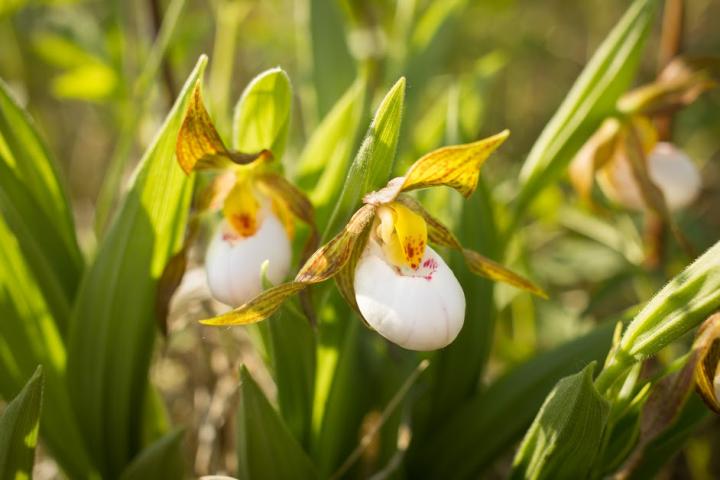For a rare prairie orchid, science is making climate change local

The small white lady's slipper is listed as endangered, threatened, rare or extirpated throughout most of its historic range, which extends extending from the Dakotas and Nebraska east to New York, Pennsylvania and Maryland, and from southern Canada south to Missouri, Kentucky and Virginia. Credit: Justin Meissner
Knowing how climate change may affect an entire region is only marginally useful to land managers trying to preserve the small white lady's slipper, a once-abundant orchid that today is found in small “postage stamp” prairie fragments as little as 10 acres in size in Minnesota and another dozen states across the Midwest. Land managers need the details: how might a small fragment of orchid habitat change with climate change, and what climate adaptation strategies will be most effective in preserving remaining populations of small white lady's slipper?
Research by University of Minnesota and USDA Forest Service scientists is helping answer those questions. Robert Haight and Stephanie Snyder of the USDA Forest Service's Northern Research Station in St. Paul, Minn., worked with principal investigator Laura Phillips-Mao and Susan Galatowitsch, both with the University of Minnesota, to create a dynamic model that focuses on site scale conservation.
Development of the model is described in a study, “Model-based scenario planning to develop climate change adaptation strategies for rare plant populations in grassland reserves,” which was recently published by the journal Biological Conservation and is available from the Northern Research Station at: http://www.
The small white lady's slipper orchid occurs in wet prairies, meadows, and fens and is a high risk species with respect to climate change because its wet prairie habitat is considered vulnerable to regional climate change impacts such as water table drawdowns and increased frequency of severe drought. Regional climate change projections may indicate higher temperature and more variable precipitation, but resulting changes in soil water availability will depend on local features, including soil texture and drainage, vegetative cover, topography and hydrology. On a site scale, climate change impacts may not manifest uniformly, and areas of currently suitable habitat for a given species may vary in their vulnerability to climate change.
“Our model accounts for these site-level features when projecting the potential impacts of different climate change scenarios,” said Phillips-Mao. “The model delivers information about management strategies that is specific to the location and the plant itself, which gives managers much more certainty in decision-making.” For the small white lady's slipper, such decisions may include whether to prioritize invasive species management, protect critical groundwater recharge areas, or increase monitoring intensity to detect population responses to drought and other environmental stressors.
“Modeling that makes the anticipated regional effects of climate change site-specific has the potential to benefit other rare species with very limited ranges,” said Haight. “This approach gives conservation planners and practitioners information they need to make sound, on-the-ground management decisions in the face of climate change.”
The small white lady's slipper is listed as endangered, threatened, rare or extirpated throughout most of its historic range, which extends extending from the Dakotas and Nebraska east to New York, Pennsylvania and Maryland, and from southern Canada south to Missouri, Kentucky and Virginia.
The mission of the Forest Service's Northern Research Station is to improve people's lives and help sustain the natural resources in the Northeast and Midwest through leading-edge science and effective information delivery.
The mission of the Forest Service, part of the U.S. Department of Agriculture, is to sustain the health, diversity, and productivity of the Nation's forests and grasslands to meet the needs of present and future generations. The agency manages 193 million acres of public land, provides assistance to state and private landowners, and maintains the largest forestry research organization in the world. Public lands the Forest Service manages contribute more than $13 billion to the economy each year through visitor spending alone. Those same lands provide 20 percent of the Nation's clean water supply, a value estimated at $7.2 billion per year. The agency has either a direct or indirect role in stewardship of about 80 percent of the 850 million forested acres within the U.S., of which 100 million acres are urban forests where most Americans live.
Media Contact
All latest news from the category: Earth Sciences
Earth Sciences (also referred to as Geosciences), which deals with basic issues surrounding our planet, plays a vital role in the area of energy and raw materials supply.
Earth Sciences comprises subjects such as geology, geography, geological informatics, paleontology, mineralogy, petrography, crystallography, geophysics, geodesy, glaciology, cartography, photogrammetry, meteorology and seismology, early-warning systems, earthquake research and polar research.
Newest articles

Superradiant atoms could push the boundaries of how precisely time can be measured
Superradiant atoms can help us measure time more precisely than ever. In a new study, researchers from the University of Copenhagen present a new method for measuring the time interval,…

Ion thermoelectric conversion devices for near room temperature
The electrode sheet of the thermoelectric device consists of ionic hydrogel, which is sandwiched between the electrodes to form, and the Prussian blue on the electrode undergoes a redox reaction…

Zap Energy achieves 37-million-degree temperatures in a compact device
New publication reports record electron temperatures for a small-scale, sheared-flow-stabilized Z-pinch fusion device. In the nine decades since humans first produced fusion reactions, only a few fusion technologies have demonstrated…





















